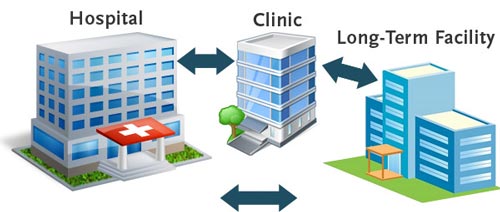July 14, 2016

The Post-Acute Gold Rush: Winning the Race to the Claims Office
Gold’s glitter and the lure of quick riches led 90,000 unruly prospectors to California in 1849. The gold rush was on and it had rules. Prospectors had to actively work their claims to ward off claim-jumpers. Outcomes didn’t matter to government regulators, only activity.
In the long run, few struck it rich. The real money went to merchants, like Levi Strauss, servicing the gold-diggers. It also went to savvy companies that acquired the best claims and applied technology, organization and muscle to unearth large caches of gold. Grizzled prospectors stood by and watched. Eventually, most packed their mules and headed north in search of new fortunes. Almost all faded away.
For decades, post-acute care companies have seen “gold in them thar Medicare hills.” They’ve structured operations to optimize reimbursement revenues, not quality or value. Patients have suffered. Driven by new payment models, savvy companies are redesigning post-acute care delivery to emphasize better transitions, coordination and outcomes.
The fragmented operators are packing up and fading away. This is good for American healthcare. A compelling question for health systems is whether they will participate in reshaping post-care delivery or cede their claims to others.
The Dystopian World of Post-Acute Care

Hospitals are the portals through which patients receive PAC services. Medicare reimbursement encourages hospitals to minimize average lengths of stay, so discharged patients needing recuperative and rehabilitation services transition to PAC providers. More than a third of all hospital patients[1] and 42% of Medicare patients[2]require post-acute care.
Mirroring Medicare reimbursement, the following four “business lines” offer PAC services and collectively accounted for $59.4 billion in Medicare’s 2013 program spending:
- Skilled Nursing Facilities (SNFs) – $28.7B
- Home Health Agencies (HHAs) – $18.3B
- Inpatient Rehabilitation Facilities (IRFs) – $6.9B
- Long-Term Acute Care Hospitals (LTACs) – $5.5B[3]
Even though 60% of Medicare patients use PAC services[4], there are no clear guidelines for discharging patients among these four PAC service lines. There is significant overlap. Discharge planners often assign patients to available, not targeted, facilities. Historically, hospitals have not had financial incentives to coordinate PAC services.
A lack of care coordination has led to significant levels of PAC treatment variation and sub-par PAC outcomes. On average, Medicare pays for 2000 days of PAC services for every 1000 patients. Roughly a fifth of Medicare patients require readmission to hospitals, often for preventable conditions.
By contrast, Kaiser Permanente averages just 600 days of PAC services per 1000 patients and achieves very low readmission rates.[5] Clearly, there is enormous room for care improvement and cost savings.[6]
A damning Wall Street Journal report revealed in 2015, long-term-acute care hospitals disproportionately discharge patients once their length-of-stay meets “threshold” payment levels. During the study’s six-year review period, the authors found that each day reduction in LTAC length-of-stay would have saved Medicare $2 billion.[7]
Here’s how entrenched the perverse incentives have become. The Center for Medicare and Medicaid Services (CMS) has instituted new payment criteria to reward PAC providers for marginal length-of-stay reductions. Improving patient outcomes is, at best, a secondary consideration.
Reversing Course
 The emergence of new payment models and penalties require care coordination across an entire care episode from pre-admission through acute and post-acute care. Bundled and capitated payment models provide a fixed level of reimbursement per patient or episode to high-quality, cost-effective care. The introduction of financial risk forces providers to rethink their approach to PAC delivery and coordination.
The emergence of new payment models and penalties require care coordination across an entire care episode from pre-admission through acute and post-acute care. Bundled and capitated payment models provide a fixed level of reimbursement per patient or episode to high-quality, cost-effective care. The introduction of financial risk forces providers to rethink their approach to PAC delivery and coordination.
Not only does the practice of extending treatment duration spike costs, it also increases risk for infections, falls, medication errors, overtreatment and depression. PAC services are fragmented, brittle, riddled with failure and excessively expensive.
The pressing need for improved PAC outcomes creates a substantial business opportunity. Some health systems, such as Kaiser, are realizing substantial benefits by coordinating acute and post-acute care delivery. Independent companies are also striving to meet this pressing market need.
For most health systems, however, improved PAC coordination is not a strategic priority. They may realize its importance but, unlike Kaiser Permanente, rarely take aggressive actions to improve care coordination and reduce readmissions. In essence, health systems are willing to cede this “claim” to others.
This is unfortunate because there is a post-acute gold rush underway. Under pressure for improved quality and outcomes, health systems must choose among the following two alternatives for improving PAC coordination:
- Organize a system-specific PAC network to advance care coordination, take greater care coordination risk and potentially realize significant financial benefit; or
- Contract with independent companies for PAC coordination and forgo potential financial rewards.
Ignorance and/or doing nothing are no longer alternatives. Payment will follow coordinated, high-quality care delivery.
Collecting Golden Nuggets: Implications of the New Payment Paradigm

In 2012, Cain Brothers issued an in-depth analysis of the post-acute sector that anticipated and explained this value-driven movement to improve PAC services. As Cain Brothers predicted, CMS is promoting innovation in post-acute care delivery by introducing new value-based pricing models with quality metrics and associated carrots and sticks.
Significantly, new companies are emerging to compete for control of PAC services coordination. These are early prospectors with evolving business models. Fortunately for them, the performance bar is very low. As long as they’re focused and engaged, even mediocre companies can add value. Expect them to improve their PAC coordination capabilities over time.
NaviHealth, acquired in 2015 by Cardinal Health, is among the most notable. The company employs technology and on-site care coordinators to enhance PAC services on behalf of its health system and payer clients. The company applies proprietary PAC utilization models and rigorous monitoring to optimize each patient’s care provision. Relationships between care coordinators and patients are personal and compassionate.
Confident of its ability to achieve better PAC outcomes at lower costs, NaviHealth accepts significant financial risk. It guarantees savings at least 2% below current average PAC costs and shares savings beyond this threshold with clients.
Darien, CT-based, Remedy Partners, is a healthcare services firm that is expert in managing bundled payment programs for acute and post-acute providers. Chairman Steve Wiggins calls the company a mix between Castlight and Oscar.[8] Post-acute care drives 73% of regional variation in Medicare’s cost per beneficiary, meaning there’s big upside for companies that can lower costs and improve clinical outcomes. [9]
Remedy Partners is eager to pick up these golden nuggets. The company develops tighter connections between acute and post-acute settings for its partner providers throughout the country. It brings patients and families into the coordinated process, relies on coordination technology tools to link patients and clinicians, employs a 24/7 nurse call center with centralized teams of nurses to support “in-field” care team members.
Staking a Claim: The Window is Closing for Health Systems
 Health systems are well-positioned to coordinate PAC services since they largely control current PAC referrals. To redirect volume to selected PAC partners, health systems must accomplish the following:
Health systems are well-positioned to coordinate PAC services since they largely control current PAC referrals. To redirect volume to selected PAC partners, health systems must accomplish the following:
- Identify and solicit superior PAC providers;
- Redesign care protocols to enhance care transitions and monitoring;
- Include more home-based rehabilitation and recuperation. This addresses patients’ desire for home-based care and is cost-effective. Where appropriate, home care should be a preferred PAC modality; and
- Develop shared-risk business models that reward health systems and their PAC partners for higher per-facility volume, reduced readmissions and more effective care coordination.
Absent pro-active and strategic PAC engagement, intermediaries may take control of PAC referrals, patient monitoring and quality assessment. To stay in the hunt for post-acute gold, health systems must create a strategic PAC plan and execute it.
Holistic strategic plans organize the overall delivery system, attract the best PAC partners, transmit the right patient data cohesively and improve care transitions. Properly positioned, a health system’s PAC delivery capabilities advance consumerism and business development. For example, successfully managing the healthcare risk of Medicare Advantage enrollees requires efficient, effective and coordinated PAC services.
Moreover, patients spend more time in PAC facilities than hospitals. Great PAC services provide a superior co-branding opportunity. A better overall PAC experience can differentiate a health system’s care network and create customer loyalty among a valuable client base. Patients/customers want their chosen health systems to guide their post-acute recoveries and help manage their chronic disease, so they can lead better lives.
Conclusion: It’s Now or Never
 This type of healthcare services Gold Rush has happened before. The market-based reforms instituted under the Medicare Modernization Act of 2003 led to geometric growth of pharmacy benefit companies (PBMs). Health systems largely ceded this market opportunity to private companies and they experienced explosive growth.
This type of healthcare services Gold Rush has happened before. The market-based reforms instituted under the Medicare Modernization Act of 2003 led to geometric growth of pharmacy benefit companies (PBMs). Health systems largely ceded this market opportunity to private companies and they experienced explosive growth.
Industry leader Express Scripts ranked 147 on the Fortune 500 in 2003 with revenues of $13 billion. By 2013, Express Scripts achieved $105 billion in revenues and cracked the Fortune 20. With few exceptions, health systems today are secondary PBM players with limited market presence and negotiating leverage.
Market-driven care coordination of PAC services today has the same growth potential as pharmacy benefit management did a decade ago. Winning companies will differentiate based on outcomes, quality, costs and customer experience.
Competition and activity is already picking up. Cardinal Health purchased a majority interest in NaviHealth in 2015. The deal gives Cardinal leading capabilities in the value-based delivery of PAC services and gives NaviHealth added strength in pharmaceuticals. As NaviHealth CEO, Clay Richards, commented on the Cardinal acquisition:
That’s the sound of a prospector spotting gold and shouting “Eureka!” The post-acute gold rush is on.
Capitalism’s inherent beauty is its ability to allocate resources efficiently among market participants. Outcomes, not process, triumph. Customers matter. Value rules.
Health systems largely missed the PBM opportunity. Intermediaries created most of the value and claimed the spoils. What will be the outcome this time? Will health systems strike it rich or will they abandon their claims to others?
History will tell the tale.
 Wyatt Ritchie
Wyatt Ritchie
Wyatt Ritchie is a senior banker focusing on Post-Acute Care and Outsourced Services. Mr. Ritchie joined Cain Brothers in 2010 with over 23 years’ experience advising both public and private companies in a variety of merger and acquisition, capital raising, and strategic advisory transactions. Cain Brothers is a pre-eminent investment bank focused exclusively on healthcare. Our deep knowledge of the industry enables us to provide unique perspectives to our clients and is matched with the knowhow needed to efficiently execute the most complex transactions of all sizes. www.cainbrothers.com
 Bill Pomeranz
Bill Pomeranz
Bill Pomeranz is a senior banker in the Firm’s Post-Acute Care Advisory practice. Mr. Pomeranz joined Cain Brothers in 1998 and has over 35 years’ experience advising post-acute care providers, CCRCs, and senior living facilities. Cain Brothers is a pre-eminent investment bank focused exclusively on healthcare. Our deep knowledge of the industry enables us to provide unique perspectives to our clients and is matched with the knowhow needed to efficiently execute the most complex transactions of all sizes. www.cainbrothers.com





